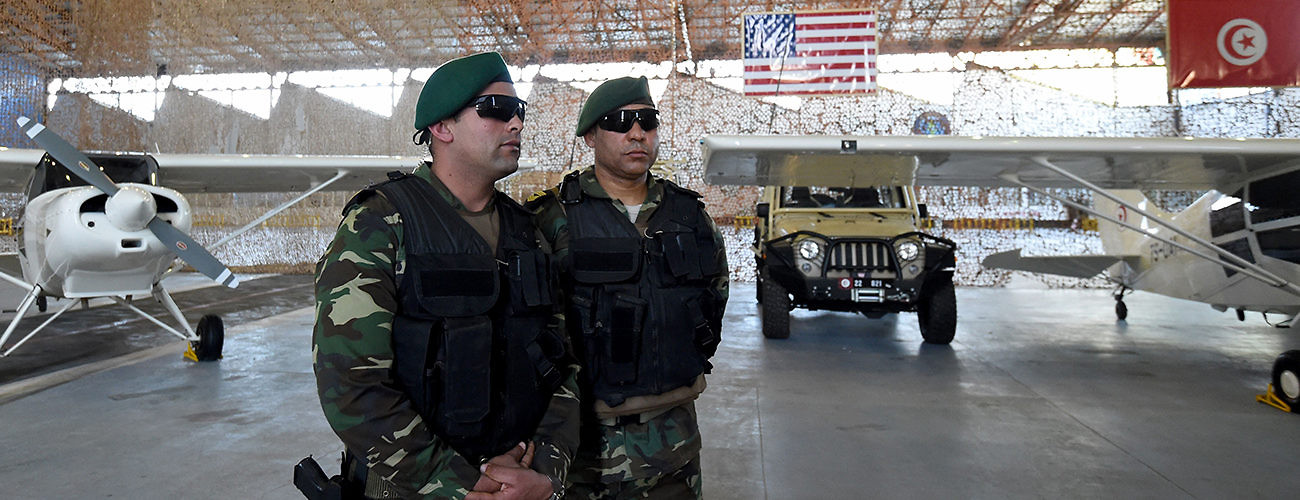Tunisian army personnel stand by military equipment provided by the United States to help in the fight against ISIS. Tunis, Tunisia, May 12, 2016. (Fethi Belaid/AFP/Getty Images)
The Muslim holy month of Ramadan, which began this week, has proven a popular time for jihadist extremists to launch attacks globally. Tunisia will be among those countries on highest alert, following a spate of violence over the past 18 months that has threatened its fragile stability. As the Islamic State (ISIS) faces considerable setbacks elsewhere, increased vigilance will be particularly focused on heading off the ambitions of this group within the North African country.
Tunisia has shown considerable resilience against the problems that have plagued other post-Arab Spring states, as was evident in last year’s awarding of the Nobel Peace Prize to its National Dialogue Quartet, which protected the country’s 2011 revolution from devolving into chaos. Nonetheless, Tunisia continues to face challenges from extremist violence, its subsequent economic impacts, and the political instability this potentially foments.
A memorandum of understanding on fighting terrorism signed with India last week shows the seriousness with which the government is treating the problem, and also its wider-ranging regional implications. Tunisia also received $20 million worth of arms from the United States in May, with the intention of fighting the threat of ISIS, particularly along the border with Libya.
Tunisia’s two major terrorist attacks in the first half of 2015—on the Bardo Museum in Tunis and a resort near Sousse—had a devastating impact on its vital tourism industry. As a result of these, visitor numbers took a big hit in 2015 and are reported to be down 20% for the first quarter of this year. Foreigner-frequented areas remain at risk, particularly during Ramadan, which has typically provided terrorists and Islamist militants with added ideological and operational motivation to launch attacks.
Coupled with the threat to tourists has been persistent Islamist militant activity along Tunisia’s long and porous borders with Islamist-embattled Algeria and Libya. At least 50 people were killed on March 7 this year in Ben Guerdane, when scores of Libyan-based militants poured in and attacked security installations in the town and surrounding areas. Further inland, four security personnel were also killed by militants less than a month ago, during an operation in the city of Tataouine.
Authorities have gone to great lengths to stem the flow of violence, including, in recent weeks, through a campaign of arrests of terrorist suspects and attempts to neutralize high-ranking Islamist militant commanders. The majority of operations have focused on the Kasserine, Medenine, and Tataouine governorates along the Libyan and Algerian borders. The campaign scored a significant victory last month with the reported killing of Seifeddine Jamali, the suspected commander of the ISIS-aligned Jund al-Khilafah movement, in Jebel Mghila.
Counterterrorism operations have led to the dismantling of terrorist cells, the discovery of large arms caches, and the killing of militant commanders in the desert borderlands, as well as in cities and towns, including key political, commercial, and tourist hubs. On May 11, two suspected Islamist extremists were killed during a security operation in the settlement of Mnihla in Ariana governorate, just outside central Tunis. On May 22, five suspected terrorist operatives were killed and weapons seized during a similar incident in the tourist-popular town of Zarzis in Medenine governorate. This operation, which also led to the arrest of a wanted Libyan jihadist, came days before the Lag BaOmer festival—a Jewish celebration marked on the island of Djerba, which the Israeli government warned could be targeted. More recently, a terrorist cell comprising as many as 14 members was uncovered in the town of Enfidha in the Sousse governorate.
Although these results highlight the counterterrorism prowess of Tunisia’s military, they also indicate that extremists have established a solid operational presence across the country and are targeting a range of interests, with the potential to be debilitating to the economy and political establishment. While the primary targets remain government and security interests in major centers, extremists also retain the intent and operational capacity to target foreigners, as in last year’s attacks.
Forces associated with ISIS are particularly concerning for Tunisia. As the group’s Middle Eastern reach is curtailed by internationally backed offenses, and its operational strongholds are also threatened in Libya, it is likely to attempt to conduct isolated attacks elsewhere. ISIS sees this as a key to fight against accusations that it is in decline, and was among the presumed motivations of the attacks in Paris last year and Brussels in March this year. Compounding matters is the fact that Tunisia is commonly reported to be the largest contributor of foreign fighters to ISIS in Syria and Iraq, meaning there is a significant risk of returning fighters and stranded sympathizers looking to strike out within its borders.
Under the circumstances, it seems more of a matter of when, rather than if, another major terrorist attack will occur in Tunisia. The group’s well-established presence in the country—as demonstrated by the range of targets and interests covered by recent attacks—provides a fertile environment to attempt to salvage its mantra of “remaining and expanding.” Tunisia’s resilience in the face of recent threats has been justly celebrated, but it faces a long and difficult road ahead.





